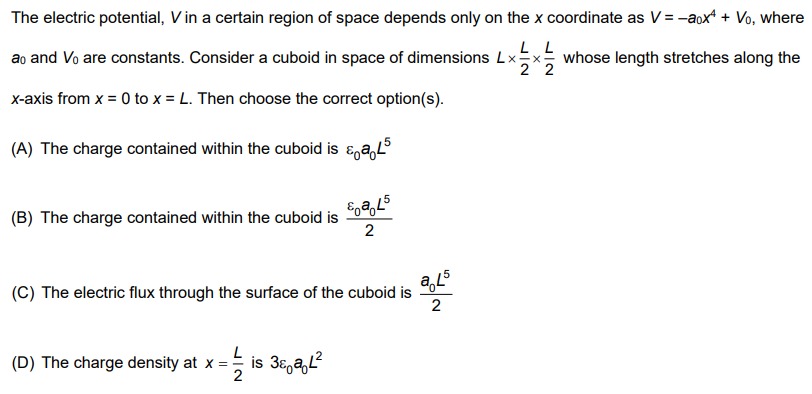Question
Question: The electric potential, $V$ in a certain region of space depends only on the $x$ coordinate as $V = ...
The electric potential, V in a certain region of space depends only on the x coordinate as V=−a0x4+V0, where a0 and V0 are constants. Consider a cuboid in space of dimensions L×2L×2L whose length stretches along the x-axis from x=0 to x=L. Then choose the correct option(s).

The charge contained within the cuboid is ϵ0a0L5
The charge contained within the cuboid is 2ϵ0a0L5
The electric flux through the surface of the cuboid is 2a0L5
The charge density at x=2L is 3ϵ0a0L2
(A), (D)
Solution
The electric potential in a certain region of space is given by V(x)=−a0x4+V0.
The electric field E is related to the potential by E=−∇V. Since V depends only on x, the electric field is in the x-direction:
Ex=−∂x∂V=−∂x∂(−a0x4+V0)=−(−4a0x3)=4a0x3.
So, the electric field is E(x)=4a0x3i^.
The charge density ρ is related to the electric field by Gauss's law in differential form: ∇⋅E=ϵ0ρ.
ρ=ϵ0(∇⋅E).
Since E=4a0x3i^, the divergence is:
∇⋅E=∂x∂Ex+∂y∂Ey+∂z∂Ez=∂x∂(4a0x3)+0+0=12a0x2.
So, the charge density is ρ(x)=ϵ0(12a0x2)=12ϵ0a0x2.
Let's check the given options:
(D) The charge density at x=2L is 3ϵ0a0L2.
Substitute x=2L into the expression for ρ(x):
ρ(2L)=12ϵ0a0(2L)2=12ϵ0a04L2=3ϵ0a0L2.
Option (D) is correct.
The cuboid has dimensions L×2L×2L and stretches along the x-axis from x=0 to x=L. Let the cuboid occupy the region 0≤x≤L, 0≤y≤L/2, 0≤z≤L/2.
The charge contained within the cuboid is Q=∫VρdV.
Q=∫0L/2∫0L/2∫0Lρ(x)dxdydz
Q=∫0L/2dy∫0L/2dz∫0L(12ϵ0a0x2)dx
Q=(2L)(2L)∫0L12ϵ0a0x2dx
Q=4L2⋅12ϵ0a0[3x3]0L
Q=3ϵ0a0L2(3L3−0)=ϵ0a0L5.
(A) The charge contained within the cuboid is ϵ0a0L5.
This matches our calculation. Option (A) is correct.
(B) The charge contained within the cuboid is 2ϵ0a0L5.
This does not match our calculation. Option (B) is incorrect.
The electric flux through the surface of the cuboid can be calculated using Gauss's law: ΦE=ϵ0Qenclosed.
Using the charge enclosed we calculated:
ΦE=ϵ0ϵ0a0L5=a0L5.
Alternatively, we can calculate the flux by integrating E⋅dA over the surface of the cuboid.
The cuboid has 6 faces. The electric field is E(x)=4a0x3i^.
The faces perpendicular to the x-axis are at x=0 and x=L.
-
Face at x=0: Area vector dA=−dydzi^. E(0)=4a0(0)3i^=0. Flux Φ1=∫E(0)⋅dA=0.
-
Face at x=L: Area vector dA=dydzi^. E(L)=4a0L3i^. Flux Φ2=∫0L/2∫0L/2(4a0L3i^)⋅(dydzi^)=4a0L3∫0L/2dy∫0L/2dz=4a0L3(2L)(2L)=a0L5.
The faces perpendicular to the y and z axes have area vectors in the j^ or k^ directions. Since E is only in the i^ direction, the dot product E⋅dA is zero for these faces.
Total flux ΦE=Φ1+Φ2+Φyfaces+Φzfaces=0+a0L5+0+0=a0L5.
(C) The electric flux through the surface of the cuboid is 2a0L5.
This does not match our calculation. Option (C) is incorrect.
The correct options are (A) and (D).
